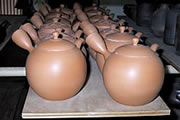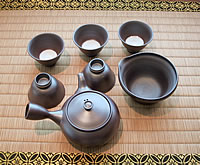Japán
„banko" teáskannák
Teakult,
a Terebess Online különlapja
Banko Ware, meaning "ancient and everlasting," got its name when the originator of the pottery, Numami Rouzan, stamped the words "bankofueki" onto his pots with a prayer that they would go on forever. I spoke to a specialist in Banko Ware teapots, who keeps alive the original function and beauty of the pottery while doing his best to manifest new styles.
Function comes first
 |
| Each
part is thrown on the wheel. Minden része fazekaskorongon készül |
Mr Mitsuki Itoh has been making Banko Ware pottery for 38 years, taking over from his father as a matter of course and producing the traditional teapots that Bankoyaki is famous for. He says he started out just helping his father make handles, spouts and lids, which he did by watching and copying. Then for the next five years he made teapots with his father to the prefiring stage which would then be fired by manufacturers. After that he went out on his own. He says that after getting his own kiln he became particularly aware of the need to make work he could be proud of. You can see this in the finished teapots he makes. Banko Ware teapots are known for their thin walls – the thinner and lighter the teapot the better. The potter must also get just the right curve on the spout so that it will not drip. Mr Itoh even thinks about the size and balance of the teapot when it is set with tea cups. He notes that since a teapot is something for everyday use, function must come first.
Finding his own "color"
 After bisque firing the wear is red. Zsengélés után vörös színt kap |
The characteristic red color of Banko Ware teapots comes from the iron-rich clayt hat it uses. The potter's skill then comes into play in the firing: a bright red color can be obtained with oxidization, while a deep brown is produced with reduction firing. The amounts of oxygen, the temperature in the kiln, the length of the firing, and the size and shape of the kiln all affect the outcome. The composition of the clay also plays a major role and Mr Itoh has put a lot of effort into getting just the right mix for his signature blend. He says there is not much you can do to change the shape of a teapot so, for variety, he has tried changing the clay to get different colors, but the teapots often became distorted in the kiln. He says he has come to be satisfied with his teapots just the way they are – "They're easy to make and I like the color," he says. I might add that no improvement is needed to the design, either. It is simple and beautiful and contains nothing superfluous.
The more you
use it
 Banko Ware in its distinctive brown color becomes more beautiful the more it is used. A használatban egyre szebbé barnul |
Banko Ware develops a beautiful sheen the more it is used because of the oil from people's hands and the tannin from the tealeaves. Mr Itoh cautions that it is not wise to scrub the teapots with detergent because this only scratches the surface and makes it go black. He says a lot of his customers choose a teapot after seeing them in action – when he serves tea – and people will often ask to buy the very teapot he used for them.